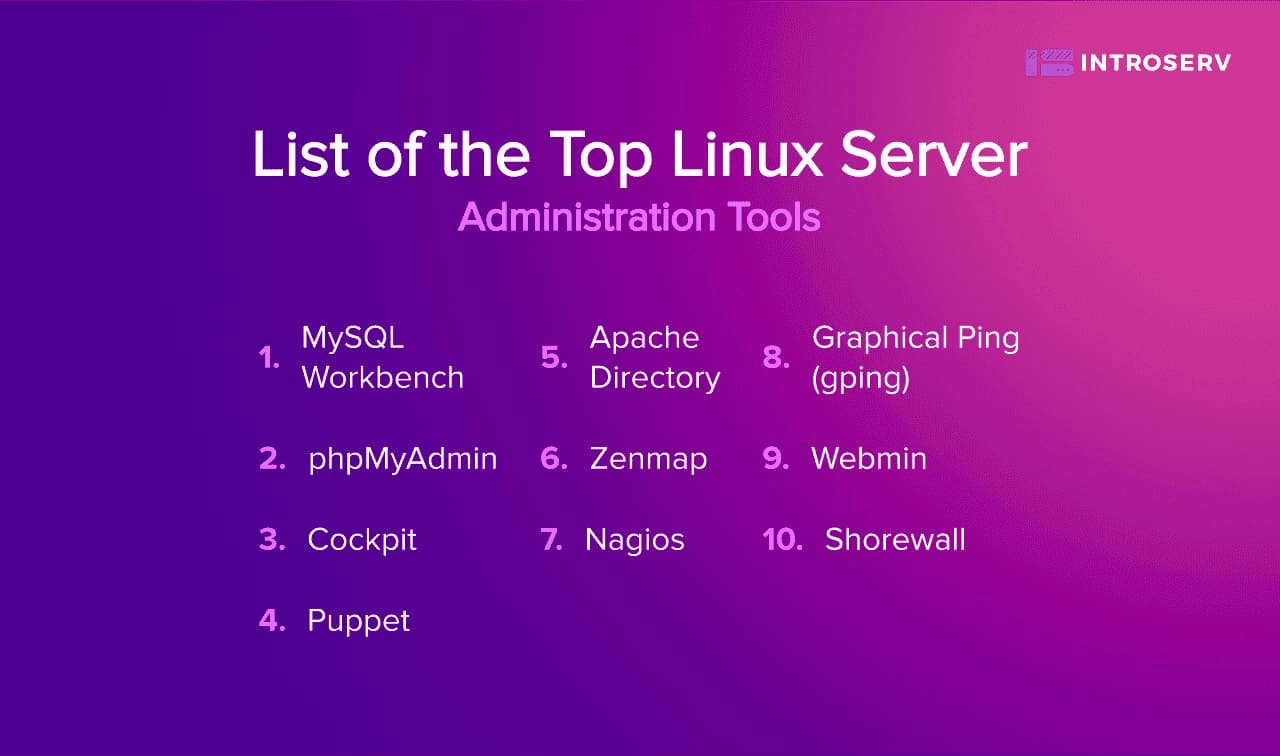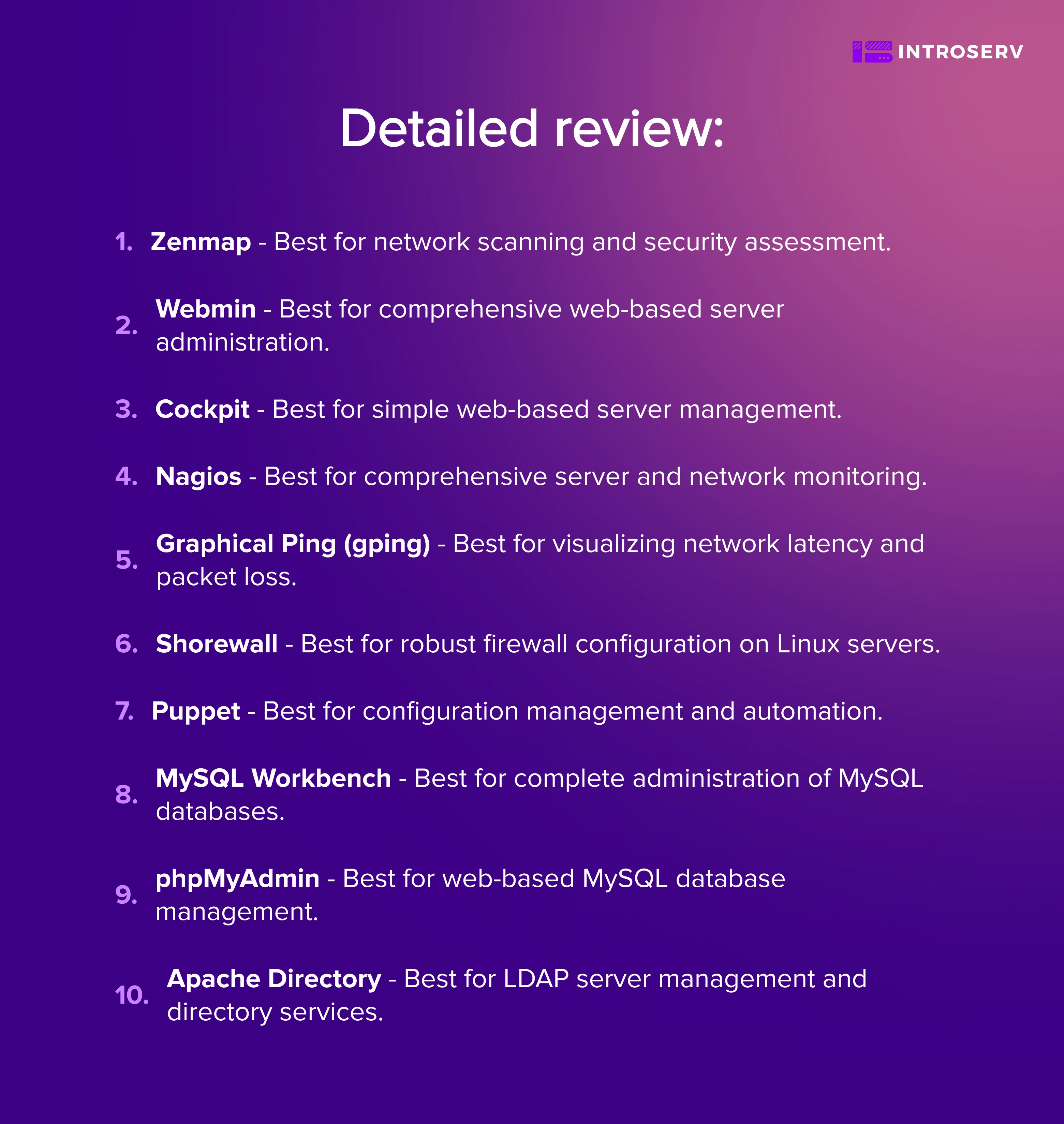
Top 10 Tools for Linux Server Administrators
Efficiently managing a Linux server requires the appropriate tools to streamline administration tasks, enhance security, and optimize performance. For this reason, Linux server administrators depend on a combination of reliable and feature-rich tools to maintain the stability and smooth operation of their infrastructure.
Within this article, we will explore the top Linux Server administration tools. These solutions encompass a broad range of functionalities, including network scanning, security assessment, web-based server management, firewall configuration, database management, and more.
We will delve into each tool, highlighting its key features and advantages, to help you make informed decisions about the tools that best suit your requirements. By the end of this read, you'll be equipped with a comprehensive understanding of the top-tier tools available, enabling you to optimize performance, bolster security, and effectively manage your Linux server infrastructure.
List of the Top Linux Server Administration Tools

Here are the TOP-10 Linux Server administration tools highly regarded for their capabilities and features:
- Zenman
- Webmin
- Cockpit
- Nagios
- Graphical Ping (gping)
- Shorewall
- Puppet
- MySQL Workbench
- phpMyAdmin
- Apache Directory
Detailed review:
#1)Zenmap
Best for network scanning and security assessment.
Zenmap is a graphical user interface (GUI) front-end for Nmap, a strong network scanner. It provides a visual representation of Nmap's output, allowing administrators to discover hosts, services, and vulnerabilities on a network. Zenmap is widely used by security professionals and network administrators for network security auditing, network exploration, and monitoring.
Features:
- Graphical interface for Nmap with an easy-to-use layout.
- Provides detailed information about hosts, open ports, and services.
- Allows customization of scan profiles and scan options.
- Supports various scanning techniques and scripts for comprehensive network exploration.
- Enables the export of scan results for further analysis.
Verdict: Zenmap is a valuable tool for network administrators and security professionals who need to conduct network scanning and security assessments. Its user-friendly interface makes it accessible to users with diverse levels of competence.
Price: Zenmap is free and open-source software.
Website: Zenmap (part of the Nmap project)
#2) Webmin
Best for comprehensive web-based server administration.
Webmin is a feature-rich web-based administration application that allows administrators to manage various aspects of a server through a browser interface. It provides a wide range of modules for system configuration, user management, package updates, and more. Webmin is highly regarded for its flexibility and ease of use, making it suitable for both novice and experienced administrators.
Features:
- Web-based interface for managing server configurations.
- Supports multiple operating systems and provides compatibility with various server software.
- Offers a wide range of modules for system administration tasks.
- Allows customization and extensibility through third-party modules.
- Provides detailed system information, logs, and monitoring tools.
Verdict: Webmin is an excellent choice for administrators seeking a comprehensive web-based server administration tool. It is appropriate for managing servers of various sizes and complexity levels because of its wide variety of modules and user-friendly interface.
Price: Webmin is free and open-source software.
Website: Webmin
#3) Cockpit
Best for simple web-based server management.
Cockpit is a web-based server management app that provides a easy-to-use interface for managing multiple servers. It offers a centralized dashboard for monitoring system resources, managing storage, network configuration, and performing administrative tasks. Cockpit is designed to simplify server management and make it accessible to administrators of all skill levels.
Features:
- Web-based interface with a clean and intuitive design.
- Supports real-time system resource monitoring, including CPU, memory, and disk usage.
- Allows administrators to manage storage, network, and user accounts.
- Includes container management, including Docker integration.
- Offers a terminal console for executing commands and troubleshooting.
Verdict: Cockpit is the best decision for administrators who prefer a user-friendly web-based interface for managing their servers. Its simplicity and ease of use make it particularly suitable for those new to server administration.
Price: Cockpit is free and open-source software.
Website: Cockpit Project
#4) Nagios
Best for comprehensive server and network monitoring.
Nagios is a widely-used monitoring software for servers, networks, and services. It provides a robust monitoring and alerting system that helps administrators proactively monitor system health, performance, and availability. Nagios supports extensive customization and is highly scalable, making it suitable for organizations of all sizes.
Features:
- Monitors system resources, network services, and custom-defined checks.
- Sends alerts and notifications via various channels, including email and SMS.
- Supports advanced monitoring features such as event handlers and performance graphing.
- Provides a web-based interface for configuring and managing monitoring settings.
- Allows integration with third-party plugins and extensions.
Verdict: Nagios is an industry-standard tool for comprehensive server and network monitoring. Its extensive features, scalability, and flexibility make it suitable for companies that require advanced monitoring capabilities and need to ensure the availability and performance of their systems.
Price: Nagios offers both open-source (Nagios Core) and commercial versions (Nagios XI), starting at $1,995 per one-time license.
Website: Nagios
#5) Graphical Ping (gping)
Best for visualizing network latency and packet loss.
Graphical Ping is a command-line tool that provides a graphical representation of ping latency and packet loss. It offers a visual output in the form of a graph, making it easier to analyze network connectivity and performance. gping is a useful solution for network troubleshooting, monitoring, and assessing network health.
Features:
- Command-line utility with a graphical output.
- Displays real-time graph of ping latency and packet loss.
- Allows customization of graph appearance and options
- Supports continuous monitoring of network connectivity.
- Helps identify patterns, spikes, or inconsistencies in network latency.
Verdict: Graphical Ping is an important tool for network administrators and troubleshooting tasks. Its ability to provide a visual representation of ping data aids in diagnosing network issues and verifying the health and responsiveness of servers.
Price: gping is open-source software and freely available.
Website: Graphical Ping (gping)
#6) Shorewall
Best for robust firewall configuration on Linux servers.
Shorewall is a powerful firewall configuration software designed for Linux servers. It simplifies the administering of network firewall rules, including port forwarding, traffic shaping, and VPN configuration. Shorewall provides administrators with a flexible and efficient way to improve network security.
Features:
- Simplifies the creation and management of iptables-based firewall rules.
- Supports various firewall zones and network interfaces.
- Allows fine-grained control over network traffic through policies and rules.
- Provides options for port forwarding, traffic shaping, and QoS.
- Includes logging and auditing capabilities for monitoring firewall activity.
Verdict: Shorewall is a recommended choice for administrators seeking a robust and flexible firewall management tool for their Linux servers. Its extensive features and configuration options make it suitable for companies that need fine-grained network control security.
Price: Shorewall is free and open-source software.
Website: Shorewall
#7) Puppet
Best for configuration management and automation.
Puppet is a popular configuration management program that allows to automate server provisioning, configuration, and deployment tasks. It helps administrators to choose the ideal configuration for servers and ensures consistent application across multiple systems. Puppet is particularly beneficial for managing large-scale server infrastructures.
Features:
- Automates system configuration and management tasks.
- Provides a declarative language (Puppet DSL) for defining desired configurations.
- Supports agent-based architecture for managing remote systems.
- Allows centralized management and reporting through a Puppet server.
- Offers a vast ecosystem of modules and resources for extending functionality.
Verdict: Puppet is highly recommended for organizations that require efficient configuration management and automation of server infrastructure. Its scalability and robustness make it suitable for managing complex environments with diverse systems.
Price: Puppet offers both open-source (Puppet Community Edition) and commercial versions (Puppet Enterprise) with additional features and support options.
Website: Puppet
#8) MySQL Workbench
Best for complete administration of MySQL databases.
MySQL Workbench is a graphical app that delivers an extensive workspace for managing MySQL databases. It provides a visual interface for designing databases, SQL programming tools, and management functions. Database administrators and developers frequently use MySQL Workbench to efficiently manage and create MySQL databases.
Features:
- Visual database design with entity-relationship diagrams (ERDs).
- SQL editor includes debugging, code completion, and syntax highlighting.
- Enables migration, schema synchronization, and database modeling.
- Provides administrative tools for server configuration, backups, and user management.
- Offers performance monitoring and query optimization features.
Verdict: MySQL Workbench is a great option for administrators and developers working with MySQL databases. It is incredibly effective for database design, SQL programming, and administration activities thanks to its wide range of capabilities and visual tools.
Price: MySQL Workbench is free and open-source software.
Website: MySQL Workbench
9) phpMyAdmin
Best for web-based MySQL database management.
phpMyAdmin is a well-liked web app for managing MySQL databases. It offers a user-friendly interface for performing various database administration tasks, including creating, modifying, and querying databases, tables, and records. phpMyAdmin is widely used for its simplicity and convenience in web-based MySQL database management.
Features:
- Web-based interface accessible through a browser.
- Intuitive GUI for managing databases, tables, and records.
- Supports SQL query execution and customization.
- Provides import and export functionalities for data transfer.
- Offers user management and database security features.
Verdict: phpMyAdmin is a recommended choice for administrators who prefer a web-based interface for managing MySQL databases. Its user-friendly interface and essential features make it suitable for basic database administration tasks.
Price: phpMyAdmin is free and open-source software.
Website: phpMyAdmin
#10) Apache Directory
Best for LDAP server management and directory services.
Apache Directory is an open-source LDAP server and management tool. It provides a platform for storing and managing directory information, such as user accounts and network resources. Apache Directory is specifically designed for managing LDAP servers and supporting directory services.
Features:
- LDAP server capabilities with support for LDAPv3 protocol.
- Allows managing directory entries, attributes, and schema.
- Supports LDAP replication for high availability.
- Provides tools for user management and access control.
- Offers a web-based administration interface.
Verdict: Apache Directory is a valuable tool for administrators who need to manage LDAP servers and directory services. Its specialized features and support for LDAP protocols make it suitable for organizations that rely on directory services for user management and resource access.
Price: Apache Directory is free and open-source software.
Website: Apache Directory

Experience the Ease of Linux Server Management with INTROSERV
INTROSERV understands the challenges of managing Linux servers, and we are here to simplify your experience while maximizing the potential of your infrastructure. Our comprehensive services include server administration and managed server solutions, offering you the expertise and support needed for optimal performance, enhanced security, and seamless operations.
With our server administration service, we aim to lighten your workload, freeing you to concentrate on your core business objectives. Our dedicated team will take care of server configuration, monitoring, troubleshooting, and maintenance, ensuring smooth and efficient operations.
For added convenience, our managed server solutions cover the entire server management process. From hardware provisioning to software updates and security patches, we handle it all. Trust our expertise to keep your servers up-to-date, secure, and performing at their best, allowing you to drive your business forward.
Contact us today to discuss your needs and unlock the full potential of your Linux servers with our expert services.








